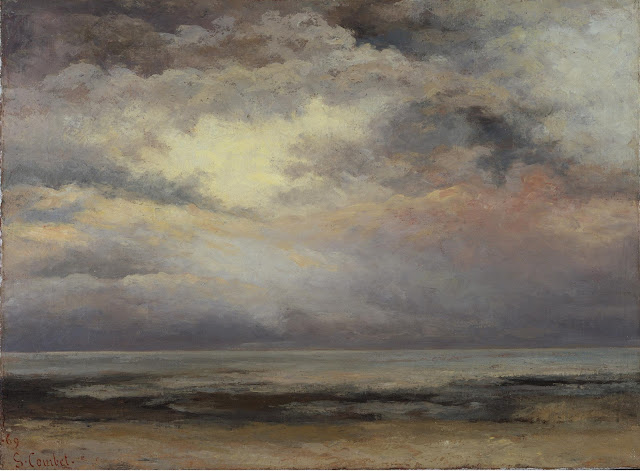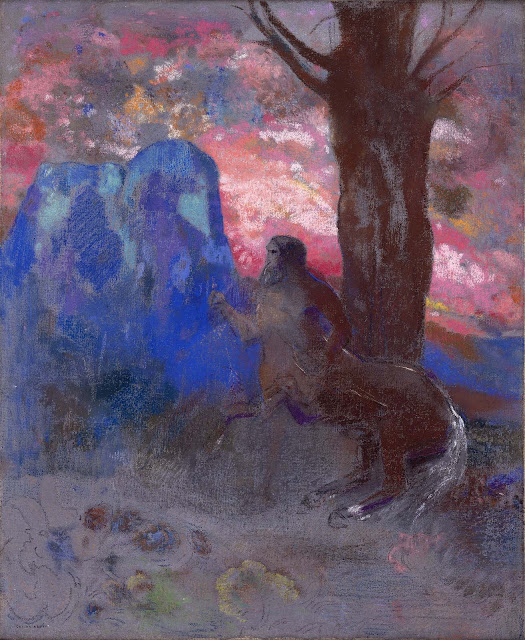 |
| Henri-Joseph Harpignies By the Stream 1882 watercolor Museum of Fine Arts, Boston |
 |
| Rosa Bonheur Ploughing Scene 1854 oil on canvas Walters Art Museum, Baltimore |
 |
| Paul Gauguin Entrance to the Village of Osny 1882-83 oil on canvas Museum of Fine Arts, Boston |
"Plato, we know, looked back with nostalgia at the immobile schemata of Egyptian art. In the work of his old age, the Laws, he speaks with disapproval of the licence the Greeks allow their musicians 'to teach whatever rhythm or tune', and he commends the Egyptians, who long ago 'determined on the rule . . . that the youth of a State should practise in their rehearsals only postures and tunes that are good: these they prescribed in detail and posted up in the temples, and outside this official list it was and still is forbidden to painters and all other producers of postures and representations to introduce any innovation or invention, whether in such productions or in any other branch of music over and above the traditional forms. And if you look there, you will find the things depicted or graven there 10,000 years ago (I mean what I say, not loosely but literally 10,000) and no whit better or worse than the productions of today, but wrought with the same art.'
"Is it too much to infer Plato saw in the conceptual style of Egypt a nearer approach to the art of the couch-maker, who imitates changeless ideas rather than fleeting appearances? For this is precisely what the famous passage in the Republic suggests. 'Does a couch differ from itself according to how you view it from the side or the front or in any other way? Or does it differ not at all in fact though it appears different?' It is first of all for this reason – for his failure to represent the couch as it is by itself and for including only one aspect of it in his picture – the the artist is condemned as a maker of phantoms. But that is not all. 'The same magnitude, I presume, viewed from near or far does not appear equal. – Why, no. – And the same things appear bent and straight to those who view them in water and out, or concave and convex, owing to similar errors of vision about colours and there is obviously every confusion of this sort in our souls. And so scene-painting in its exploitation of this weakness of our nature falls nothing short of witchcraft, and so do jugglery and many other such contrivances.'
"The picture conjured up by art is unreliable and incomplete, it appeals to the lower part of the soul, to our imagination rather than to our reason, and must therefore be banished as a corrupting influence."
– E.H. Gombrich, from Art and Illusion: a Study of the Psychology of Pictorial Representation, originally delivered as the A.W. Mellon Lectures in the Fine Arts, 1956
 |
| Gustave Courbet Stream in the Forest ca. 1862 oil on canvas Museum of Fine Arts, Boston |
 |
| Gustave Courbet L'Immensité 1869 oil on canvas Victoria & Albert Museum |
 |
| Claude Monet Cap Martin near Menton 1884 oil on canvas Museum of Fine Arts, Boston |
 |
| Alfred Sisley Waterworks at Marly ca. 1876 oil on canvas Museum of Fine Arts, Boston |
 |
| Alphonse Legros Farm with Large Tree ca. 1875 etching Museum of Fine Arts, Boston |
 |
| Lancelot-Théodore Turpin de Crissé Temple of Antoninus and Faustina 1808 oil on canvas Museum of Fine Arts, Boston |
 |
| Jean-Baptiste-Camille Corot The Willows of Marissel 1857 oil on canvas Walters Art Museum, Baltimore |
 |
| Jean-Baptiste-Camille Corot The Fisherman's Cottage 1871 oil on canvas Walters Art Museum, Baltimore |
 |
| Jean-François Millet End of the Hamlet of Gruchy 1866 oil on canvas Museum of Fine Arts, Boston |
 |
| Jean-François Millet Man Turning over Soil ca. 1847-50 oil on canvas Museum of Fine Arts, Boston |
 |
| Odilon Redon Centaur ca. 1895-1900 pastel Museum of Fine Arts, Boston |